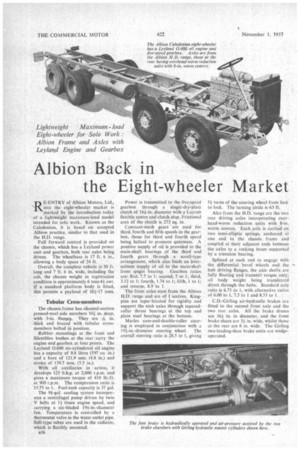Albion Back in the Eight-wheeler Market
Page 74

Page 77

If you've noticed an error in this article please click here to report it so we can fix it.
RE-ENTRY of Albion Motors, Ltd., into the eight-wheeler market is marked by the introduction today of a lightweight maximum-load model intended for solo work. Known as the Caledonian, it is based on accepted Albion practice, similar to that used in the H.D. range.
Full forward control is provided on the chassis, which has a Leyland power unit and gearbox, both rear axles being driven. The wheelbase is 17 ft. 6 in., allowing a body space of 24 ft.
Overall, the complete vehicle is 30 ft. long and 7 ft. 6 in. wide, including the cab, the chassis weight in registration condition is approximately 6 tons 44 cwt. If a standard platform body is fitted, this permits a payload of 161-17 tons.
Tubular Cross-members The chassis frame has channel-section pressed-steel side members 104 in. deep, with 3-in. flanges. They are -15,-; in. thick and braced with tubular crossmembers bolted in position.
Rubber mountings at the front and SiIentbloc bushes at the rear carry the engine and gearbox at four points. The Leyland 0.600 six-cylindered oil engine has a capacity of 9.8 litres (597 cu. in.) and a bore of 121.9 mm. (4.8 in.) and stroke of 139.7 mm. (5.5 in.).
With all auxiliaries in action, it develops 125 b.h.p. at 2,000 r.p.m. and gives a maximum torque of 410 lb./ft. at 900 r.p.m. The compression ratio is 15.75 to 1. Fuel-tank capacity is 37 gal_ The 94-gal. cooling system incorporates a centrifugal pump driven by twin V belts at If times engine speed, and tarrying a six-bladed 19+-in.-diameter Ian. Temperature is controlled by a thermostat valve in the water outlet pipe. Still-type tubes are used in the radiator, which is flexibly mounted.
D36
Power is transmitted to the five;speed gearbox through a single-dry-plate clutch of 16f-in, diameter with a Layrub flexible centre and clutch stop. Frictional area of the clutch is 273 sq. in.
Constant-mesh gears are used for third, fourth and fifth speeds in the gearbox, those for third and fourth speed being helical to promote quietness. A positive supply of oil is provided to the main-shaft bearings of the third and fourth gears through a scroll-type arrangement, which also feeds an intermittent supply of oil to the main-shaft front spigot bearing. Gearbox ratios are: first, 7.7 to 1; second, 5 to 1; third, 3.12 to 1; fourth, 1.74 to 1; fifth, Ito 1; and reverse, 8.9 'to I.
The front axles stem from the Albion H.D. range and are of I section. Kingpins are taper-located for rigidity and support the stub axles through tapered. roller thrust bearings at the top and plain steel bearings at the bottom.
Marks cam-and-double-roller steering is employed in conjunction with a 191-in.-diameter steering wheel. The overall steering ratio is 28.5 to 1, giving
51 turns of the steering wheel from lock to lock. The turning circle is 63 ft.
Also from the H.D. range are the two rear driving axles incorporating overhead-worm reduction units with 8-in. worm centres. Each axle is carried on two semi-elliptic springs, anchored at one end to the chassis frame and coupled at their adjacent ends between the axles to a rocking beam supported by a trunnion bearing.
Splined at each end to engage with the differential bevel wheels and the hub driving flanges, the axle shafts are fully floating and transmit torque only, all body weight being transferred direct through the hubs_ Standard axle ratio is 6.75 to 1, with alternative ratios of 6.00 to 1. 7.5 to 1 and 8.33 to I.
C.D.-Girling air-hydraulic brakes are fitted to the second front axle and the two rear axles. All the brake drums are 161in. in diameter, and the front brake shoes are 31in. wide, whilst those at the rear are 6 in. wide. The Girling two-leading-shoe brake units are wedgeoperated. The foot brake is hydraulically operated and air-pressure assisted by two brake chambers with Girling hydraulic master cylinders. Air pressure is provided by a two-cylindered air compressor mounted on the engine. The brake pedal is coupled directly to an air-control valve which is connected to a large air-pressure reservoir.
The niulti-pull ratchet hand brake is directly connected to the brakes of the rear axles: Total braking area provided by the foot brake is 930 sq. in.
Steel disc wheels with 10-stud fixing are used. Standard tyres are 36 x 8-in. (12-ply), with twins at the rear, Optional equipment is 9.00-20-in. (12-ply).' Four 6v. batteries with a capacity of 108 a.h. are included in the C.A.V. 24v. electrical system, which has a com
bined switch and control board incorporating fusesfor the dynamo and main
circuits. .
Similar to that used on Leyland goods vehicles of comparable capacity, the cab is a forward-control design of all-metal construction with double skin to waist height and insulation in the inner space. Lamps are flush-fitting, the radihtor grille is detachable, and there is a full-width chassis-mounted bumper.
Fitted in the front dash panel are a speedometer, oil-pressure gauge, and air-pressure gauge, whilst a combined horn push and dip switch are mounted
on the steering column. All instruments are indirectly lighted and in full view of the driver.
Chassis and cab are supplied in aluminium primer, and equipment includes front wings, tool kit with jack, spare wheel and tyre, spare-wheel carrier and an instruction manual Among the optional equipment which can be supplied at extra cost are a third differential complete with locking device on the first rear axle and controlled from the cab, powered steering, a side power take-off (24 h.p.).and an air-pressure line with hose for tyre inflation.
























































































































